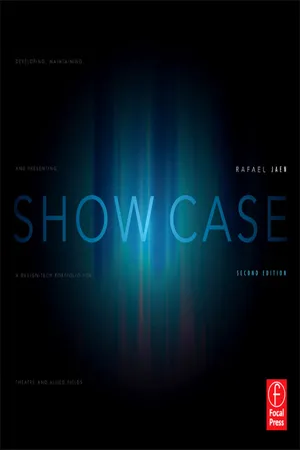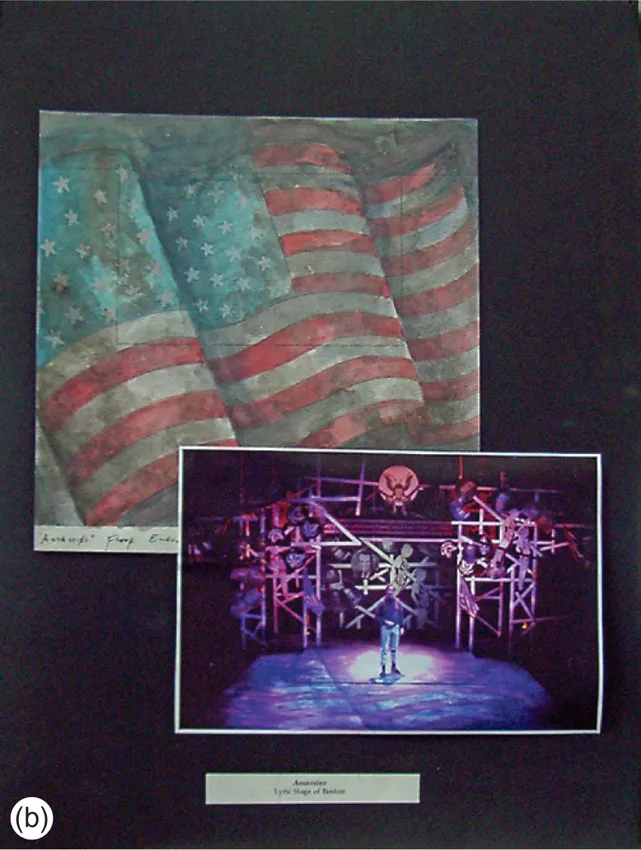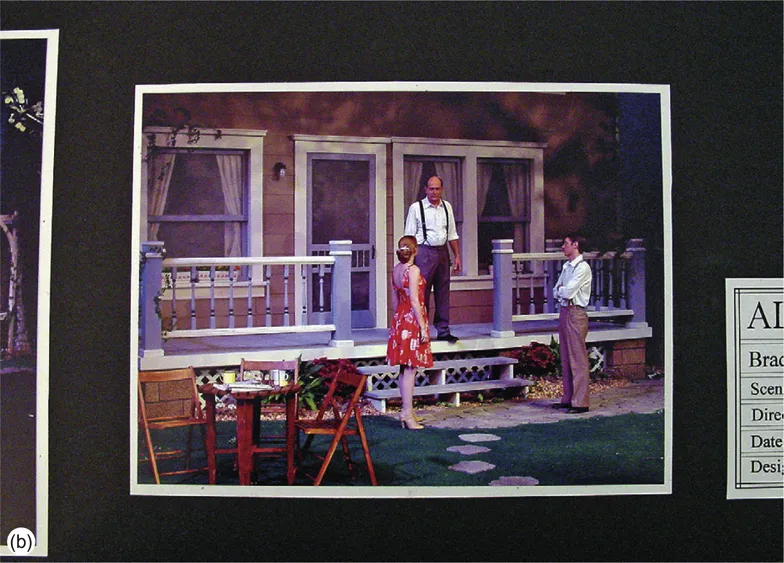
eBook - ePub
Show Case
Developing, Maintaining, and Presenting a Design-Tech Portfolio for Theatre and Allied Fields
- 248 pages
- English
- ePUB (mobile friendly)
- Available on iOS & Android
eBook - ePub
Show Case
Developing, Maintaining, and Presenting a Design-Tech Portfolio for Theatre and Allied Fields
About this book
Your theatrical portfolio will earn a standing ovation with guidance from this industry expert!
Frequently asked questions
Yes, you can cancel anytime from the Subscription tab in your account settings on the Perlego website. Your subscription will stay active until the end of your current billing period. Learn how to cancel your subscription.
At the moment all of our mobile-responsive ePub books are available to download via the app. Most of our PDFs are also available to download and we're working on making the final remaining ones downloadable now. Learn more here.
Perlego offers two plans: Essential and Complete
- Essential is ideal for learners and professionals who enjoy exploring a wide range of subjects. Access the Essential Library with 800,000+ trusted titles and best-sellers across business, personal growth, and the humanities. Includes unlimited reading time and Standard Read Aloud voice.
- Complete: Perfect for advanced learners and researchers needing full, unrestricted access. Unlock 1.4M+ books across hundreds of subjects, including academic and specialized titles. The Complete Plan also includes advanced features like Premium Read Aloud and Research Assistant.
We are an online textbook subscription service, where you can get access to an entire online library for less than the price of a single book per month. With over 1 million books across 1000+ topics, we’ve got you covered! Learn more here.
Look out for the read-aloud symbol on your next book to see if you can listen to it. The read-aloud tool reads text aloud for you, highlighting the text as it is being read. You can pause it, speed it up and slow it down. Learn more here.
Yes! You can use the Perlego app on both iOS or Android devices to read anytime, anywhere — even offline. Perfect for commutes or when you’re on the go.
Please note we cannot support devices running on iOS 13 and Android 7 or earlier. Learn more about using the app.
Please note we cannot support devices running on iOS 13 and Android 7 or earlier. Learn more about using the app.
Yes, you can access Show Case by Rafael Jaen in PDF and/or ePUB format, as well as other popular books in Media & Performing Arts & Theatre. We have over one million books available in our catalogue for you to explore.
Information
WHAT IS A DESIGN-TECH PORTFOLIO?
A PORTFOLIO IS A SHOWCASE OF …
ARTISTRY, SPECIAL SKILLS, AND PROCESS …
RAFAEL JAEN

A design-tech portfolio is a well-planned, portable case of documents and visual representations of procedures, conceptions, and materials related to various projects. All these items are carefully organized so that when the portfolio is presented to others, it can serve different functions:
1. It can serve as a showcase for the artistry, special skills, personal style, volume of work, and artistic process of a designer or a technician.
2. It can be used as a reference archive in which the designer or technician features the processes that led to ingenious design solutions.
3. It can work as a storybook that emphasizes the individual’s history, professional growth, and versatility.
Well-executed portfolios showcase a volume of work, processes, special skills, and personal style. Well-executed portfolios can open doors to new opportunities and create winning situations, such as gaining entry to graduate school, obtaining a desired job, or reaping accolades.
The process of developing and maintaining a design-tech portfolio is not different from the process that takes an idea from a two-dimensional drawing to the tri-dimensional product or that takes a concept from original rendering to realized production on the theatre stage or set of a film. To create an effective showcase, designers and technicians need to include conceptual ideas, the process by which the idea became a reality, and the finished product. They also need to edit materials and organize layouts in a way that best features their work.
The Winning Design Portfolio
Each page of the design portfolio tells the story of a specific project. To be effective, each layout must include a wide range of aspects that speak about the special skills and personal style of the designer; the project resource allocation and budget distribution; and the collaborative process with the director and the company. In the next few pages we’ll look at a few sample page choices as a way to introduce some effective practices. We’ll continue to look at more samples and go into more depth in later chapters.
Show Case
In the following pages, we see samples of various designers and technicians; they include drafting and superb photos. We start with Kristin Hayes, who won the 2007 KCACTF Region 1 Barbizon Award for Excellence in Lighting Design. Hayes says: “In showing my larger portfolio to a number of people, I found that there were a number of professionals who wanted to concentrate solely on my photographs and paperwork and regarded the research pictures as extraneous and distracting. Thus I created a smaller, more portable portfolio (8½ × 11 inches) that has the same photos and reduced plots, with shorter descriptions and no research pictures. This document was created using Microsoft PowerPoint, which allows me to reprint pages easily if I need to send a small sample of my work to a prospective employer. Also, it means I have the start of a digital portfolio!” (See Figures 1.1a through 1.1d.)
FIGURE 1.1a Award-winning lighting designer Kristin Hayes starts each new project layout with a title page.

FIGURE 1.1b Hayes includes drafting samples that can give the viewer a sense of the scale and complexity of each project. She also has actual-size drafting in the portfolio’s back pocket.

FIGURE 1.1c Hayes includes excellent photos to showcase her lighting design approach.

FIGURE 1.1d Hayes includes sections that clearly show the variety of angles used in her design. Her drafting meets U.S. Institute for Theatre Technology (USITT) industry standards.

Costume designer Jessica Champagne-Hansen creates storyboards that tell the story (from the costume design point of view) of The Shakespeare Stealer by Gary Blackwood. She won the 2004 ACTF Barbizon Design Award for Region I. Champagne-Hansen’s layout shows her inspirations and notations, as well as the realized designs (Figures 1.2a through 1.2c).
FIGURE 1.2a Award-winning costume designer Jessica Champagne-Hansen’s The Shakespeare Stealer portfolio, page 1: Project introduction, cast photo, and book cover.

FIGURE 1.2b Champagne-Hansen’s Shakespeare Stealer portfolio, page 2 (clockwise): Character sketches, including Robert Armin, Thomas Pope, and William Shakespeare.

Photos: Pope and Shakespeare, Shakespeare, Armin, and Hamlet.
FIGURE 1.2c Champagne-Hansen’s Shakespeare Stealer portfolio, page 3 (clockwise): Production photos of character Widge in beige, Queen Elizabeth, Queen Elizabeth’s dress on form, and Widge in blue. Production sketches of Queen Elizabeth and Widge.

Scenic designer Janie E. Howland favors a hard portfolio. She has received many awards, including the IRNE Award and the Elliot Norton Award. She was also a founding member of CYCO SCENIC, a successful NE production company. Howland explains: “By ‘hard portfolio’ I mean a portfolio with separate pages as opposed to an electronic portfolio.” Her first sample is for the show Assassins at the Lyric Stage Company of Boston, directed by Spiro Veloudos. The overall inspiration for the set was an old-fashioned, wooden rollercoaster combined with a shooting gallery from an amusement park. Included in her portfolio layout are the paint elevation of the floor (Figure 1.3a) and a photo from the show (Figure 1.3b). The images are mounted on black matte board.
FIGURE 1.3a Set design production photo for Assassins, designed by award-winning scenic designer Janie E. Howland, at the Lyric Stage in Boston.

FIGURE 1.3b Howland’s scenic portfolio page for the show Assassins at the Lyric Stage in Boston.

Sometimes it is important to combine research, process, and layout technique in a portfolio page to contextualize a design approach. For example, costume designer William Henshaw created portfolio pages for the show American Tragedy: The Case of Clyde Griffiths, mounted at San Diego State University in April 1996. Henshaw says: “The premise of this show was that it was yellow journalism; therefore, the renderings were left uncolored and very grainy so as to resemble newsprint and pictures from the 1930s. Preliminary sketches were done all on one page to resemble a layout for a newspaper (Figures 1.4a and 1.4b). Research for the show was presented on boards to give the feel of a newspaper layout.”
FIGURE 1.4a Costume designer William Henshaw’s costume rough sketch for American Tragedy at San Diego State University, 1996.

FIGURE 1.4b Henshow’s final costume design page for American Tragedy.

Some of the design-tech disciplines are more abstract and therefore difficult to explain visually in a portfolio; this is true, for example, of lighting design. To properly present projects for this discipline, good photos showing clear angles, color fillers, and shadows are desirable. They will help emphasize the special talents and sensibilities of the designer. For The Idiot, adapted and directed by Alexandre Marine, lighting designer Nicholas Vargelis used white light and sharp angles to add to the high emotional tension in various scenes. The photos in Figures 1.5a and 5b are from the portfolio sequence for this show. To best show his lighting choice, Nicholas uses photos sized to 8 ½ × 11 inches and printed on quality photo paper.
FIGURE 1.5a Show: The Idiot, adapted and directed by Alexandre Marine. Scene: General Yepanchin’s Gift to Nastasya. Lighting by Nicholas Vargelis. Produced at ART Institute for Advanced Theatre Training, June 2004.


Nicholas Vargelis’s lighting portfolio consists of a series of large (8 ½ × 11-inch) photographs. The sequences show his range of design for various plays; each show is clearly labeled and arranged by scene. Right after the photos for The Idiot, he showcases his atmospheric and soft lighting for the show Mud by Maria Irene Fornes (Figures 1.5c and 1.5d). The photos show contrast in Vargelis’s design abilities.
FIGURES 1.5c and 1.5d Nicholas Vargelis’s lighting design photo/portfolio pages (showing contrast) for Mud, by Maria Irene Fornes; scene 1.6 (The Starfish) and scene 1.7 (What is Lloyd?); ART Institute for Advanced Theatre Training, June 2003.

Anthony Phelps is a set and lighting designer. He holds a masters of fine arts (MFA) in design from Minnesota State University, Mankato. His professional memberships include United Scenic Artists, the International Alliance of Theatrical Stage Employees (IATSE), and USITT. His portfolio contains what I call a classical storyboard approach that proves very effective for his personal style (Figures 1.6a through 1.6b).
FIGURE 1.6a Set and lighting designer Anthony Phelps’s portfolio case with storyboards.

FIGURE 1.6b Phelps’s detail photo. With the storyboard approach, photos can be seen without the sheet holders’ glare.

For a sound design portfolio, designer Andy Leviss recommends including one-block diagram samples of the sound system for a show—one, two, or more, depending on the show. “This is the most visual that a sound design portfolio often gets,” he says. “It has the benefits of both...
Table of contents
- Cover
- Halftitle
- Title
- Copyright
- Contents
- Preface
- Introduction
- Introduction to the Second Edition
- PART I. What is a Design-Tech Portfolio?
- PART II. What is an Electronic Portfolio?
- PART III. Presenting and Marketing the Portfolio
- PART IV. Portfolio Maintenance and Next Steps
- PART V. Contributors First Edition
- Index